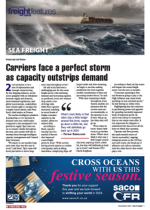2024 promises to be a year of adjustments and strategic manoeuvring for the shipping industry. As the sector grapples with an imbalance between supply and demand, environmental regulations, and global uncertainties, stakeholders must remain agile to navigate the complex waters ahead, said Peter Sand, chief analyst at Xeneta.The market intelligence platform is projecting a 2.5% increase in demand next year, which pales compared to the anticipated 6.5% growth in supply. Spot rates are set to remain volatile throughout the year, and carriers will aim to increase these through intelligent capacity management and General Rate Increases.“We expect to see steadier long-term rates than was the case in 2023,” said Sand. “Spot rates will hover just below or above long-term rates throughout 2024.”He said 2023 had been a challenging year for the ocean freight sector, with declining demand and increasing capacity. As predicted, 2023 saw volumes drop amid a cost-of-living crisis while f leet capacity increased, resulting in record levels of freight container capacity on the market, albeit not utilised fully.According to Sand, capacity was just one of a myriad of factors that impacted ocean freight prices in 2023. “With carriers having several options to combat overcapacity, such as idling, demolition, redeploying ships off larger trades and slow-steaming, we begin to see that making predictions for 2024 requires careful consideration of data and upcoming market forces,” he said.With rates remaining volatile throughout 2023, Xeneta analysts are adamant that the current rates are not sustainable, so the question is not if rates will go up but when they will go up.“From what we know, there’s little room to go further down. What’s most likely is they stay a little longer around this level, maybe go down a little bit, but they will definitely go back up in 2024,” said Xeneta CEO Patrik Berglund.According to Sand, six key issues will impact the ocean freight sector over the next 12 months.“Consumer spending is first and foremost going to play a role. High inf lation may mean lower spending on non-essential goods,” he said during an online event.Highlighting that the reduction in purchasing power and appetite for spending inevitably impacted levels of imported goods, he said it was critical to remember that no two trades were alike. It was important for shippers to understand the data across all the lanes in which they operated.Capacity and f leet growth, the much-needed return of ‘classic seasonality’, ongoing industrial action on the US East and Gulf coasts, the break-up of alliances and carbon emissions were the other factors that would play a role.

